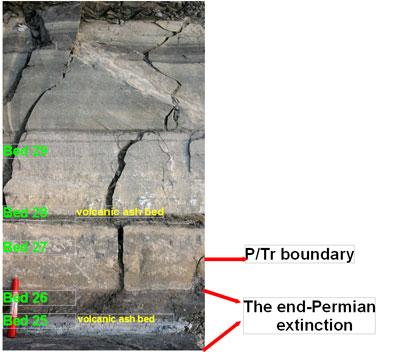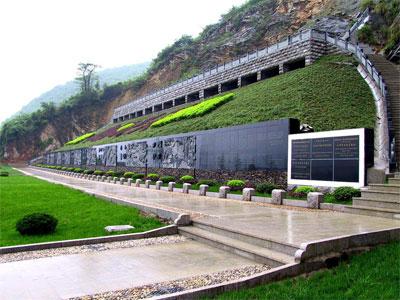A team of researchers, led by Dr. SHEN Yan'an, at CAS Key Laboratory of Crust-Mantle Materials and Environments, School of Earth and Space Sciences, University of Science and Technology of China (USTC) reported a new line of geochemical evidence to explain the most devastating extinction in the history of metazoan life. The paper entitled "Multiple S-isotopic evidence for episodic shoaling of anoxic water during Late Permian mass extinction" was published in Nature Communications on Feb 22, 2011.

Figure 1. The Meishan section showing the extinction interval and the Permian-Triassic boundary/Shen Yan'an
The end-Permian mass extinction has killed more than 90% of marine species in global scale. Many hypotheses have been proposed to explain this extinction. However, the cause of biodiversity crisis before the final catastrophe has received little study.
SHEN Yan'an and his colleagues carried out detailed geochemical analyses on the Meishan Section in Zhejiang Province, South China. The Meishan section is the Global Stratotype Section and Point (GSSP) for the Permian-Triassic boundary. SHEN and colleagues measured multiple S-isotopic compositions of pyrites from the Meishan section.
They observed an anomalous sulfur isotope signal that correlates with the extinction processes. Based on principles of S-isotopic fractionation as well as ocean chemistry of the Late Permian, SHEN and colleagues believe that the anomalous S-isotopic signal may have resulted from shoaling of anoxic water.
The episodic occurrence of the anomalous S-isotopic signal correlates with significant biodiversity loss before the final catastrophe. SHEN Yan an and colleagues proposed that episodic shoaling of anoxic water may have contributed to biodiversity crisis before the final catastrophic extinction. The results suggest that a prolonged deterioration of oceanic environments may have caused the Late Permian extinction.
The new results may hold important implication for study of modern global climate changes.

Figure 2. The outlook of Meishan geological park in Zhejiang Province, China/SHEN Yan'an
This work was supported by National Natural Science Foundation of China.
SHEN, Y., Farquhar, J., Zhang, H., Masterson, A., Zhang, T., Wing, B.A., 2011. Multiple S-isotopic evidence for episodic shoaling of anoxic water during Late Permian mass extinction. Nature Communications 2: 210, doi: 10.1038/ncomms1217.
(School of Earth and Space Sciences of USTC, News Center of USTC)
Related News
Photos
More>>history
- Vice President ZHU Jun warmly welcomed Prof. GUO Zhengxiao, Pro-Provost,
- Vice-Rectors of The Universitat Polit cnica de Catalunya (UPC), Spain, visited
- Governor of Uppsala visited ZJU
- Delegation from Faculty of Engineering, Lund University Visited ZJU
- The International Office Holds New Year Reception for International Students
Traditions
- Chinese-German Exchange Activity was held in Hohai University
- Hohai International Students Joining in Cross-Culture Fun in Nanjing Activity
- International Students Took Part in Chinese Culture Talent Contest
- President Wang Cheng met with Vice President of University of Dundee
- Prof. Walter Graf visited Hohai University





